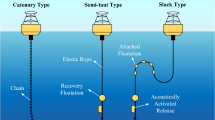Abstract
In this work consideration is given to the possibility for persistent aerial surveillance of oceans by means of quadcopters capable of taking off and landing on the sea and charging their batteries by the waves from the ocean. Clusters of relatively inexpensive ocean quadcopters equipped with conventional CCD cameras could be scattered over large and abandoned maritime areas to perform continuous and random aerial surveillance of the region. Utilizing a simple physical model, the feasibility of this novel approach for monitoring large maritime areas is assessed. Additional R & D is required in order to explore the possibilities offered by oceans quadcopters






Similar content being viewed by others
Data availability
No new data were created or analysed during this study. Data sharing is not applicable to this article.
Abbreviations
- \(A=\) :
-
Area
- \(B_e=\) :
-
Magnetic induction field
- \(D_b=\) :
-
Battery specific energy
- \(g=\) :
-
Gravity
- \(l_e=\) :
-
Length of wire/magnet
- \(L=\) :
-
Total length of wire loop
- \(M=\) :
-
Total mass of quadcopter
- \(m_b=\) :
-
Mass of battery
- \(m_c=\) :
-
Mass of converter
- \(N_e=\) :
-
Number of turns of the wire loop
- \(P_d=\) :
-
Power of the quadcopter
- \(P_e=\) :
-
Time-averaged power inductance generator
- \(r_e=\) :
-
Wire loop, magnet radius
- \(R_e=\) :
-
Load resistance
- \(s=\) :
-
Wire cross-section area
- \(t_c=\) :
-
Charging time
- \(t_f=\) :
-
Flight time
- \(v=\) :
-
Velocity
- \(x_o=\) :
-
Amplitude oscillation of magnet
- \(z_o=\) :
-
Amplitude oscillation heaving body
- \(\rho =\) :
-
Density
- \(\Psi =\) :
-
Wave parameter given by Eq.(7)
- \(\omega =\) :
-
Ocean wave frequency
- \(c=\) :
-
Converter
- \(d=\) :
-
Drone/quadcopter
- \(m=\) :
-
Magnet
- \(p=\) :
-
Propeller
- \(w=\) :
-
Wire
References
C. Whitt, J. Pearlman, B. Polagye, F. Caimi, F. Karger Muller, A. Copping, H. Spence, S. Madhusudhana, W. Kirkwood, L. Grosjean et al., Future vision for autonomous ocean observations. Front. Mar. Sci. 7, 24 (2020)
S. Guan, H. Sirianni, G. Wang, Z. Zhu, sUAS monitoring of coastal environments: a review of best practices from field to lab. Drones 6, 142 (2022)
Y. Zhang, Q.Z. Li, F.N. Zang, Ship detection for visual maritime surveillance from non-stationary platforms. Ocean Eng. 141, 53–63 (2017)
S. Fefilatyev, D. Goldgof, M. Shreve, C. Lembke, Detection and tracking of ships in open sea with rapidly moving buoy-mounted camera system. Ocean Eng. 54, 1–12 (2012)
P. Wang, X. Tian, X. Liang, X. Guo, X. Li, X. Zhang, Development of the control system for a wave driven glider. Ocean Eng. 229, 108813 (2021)
Z. Zeng, L. Lian, K. Sammut, F. He, Y. Tang, A. Lammas, A survey on path planning for persistent autonomy of autonomous underwater vehicles. Ocean Eng. 110, 303–313 (2015)
X. Sun, Y. Zhou, H. Sang, P. Yu, S. Zhang, Adaptive path following control for Wave gliders in time-varying environment. Ocean Eng. 218, 108165 (2020)
T. Omholt. A wave activated electric generator. Proceeding, Ocean 78, Marine Technology Conference. Washington, D.C., June, paper 7.3 (1978)
M.E. McCormick, Ocean wave energy conversion (Dover Publication, INC, Mineola, New York, 1981)
Author information
Authors and Affiliations
Corresponding author
Ethics declarations
Conflict of interest
The author declares that he has no known competing financial interests or personal relationships that could have appeared to influence the reported work.
Additional information
Publisher's Note
Springer Nature remains neutral with regard to jurisdictional claims in published maps and institutional affiliations.
Rights and permissions
Springer Nature or its licensor (e.g. a society or other partner) holds exclusive rights to this article under a publishing agreement with the author(s) or other rightsholder(s); author self-archiving of the accepted manuscript version of this article is solely governed by the terms of such publishing agreement and applicable law.
About this article
Cite this article
Arias, F.J., Heras, S.D.L. Ocean quadcopters: persistent and autonomous aerial surveillance of large maritime areas by quadcopters self-powered by ocean waves. Mar Syst Ocean Technol (2024). https://doi.org/10.1007/s40868-024-00134-z
Received:
Accepted:
Published:
DOI: https://doi.org/10.1007/s40868-024-00134-z




